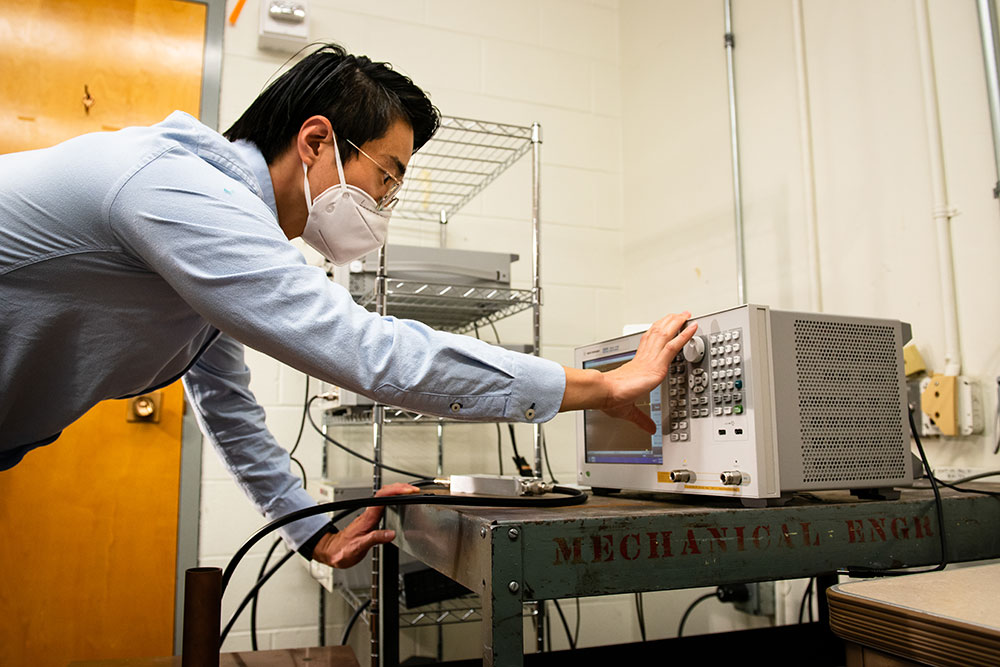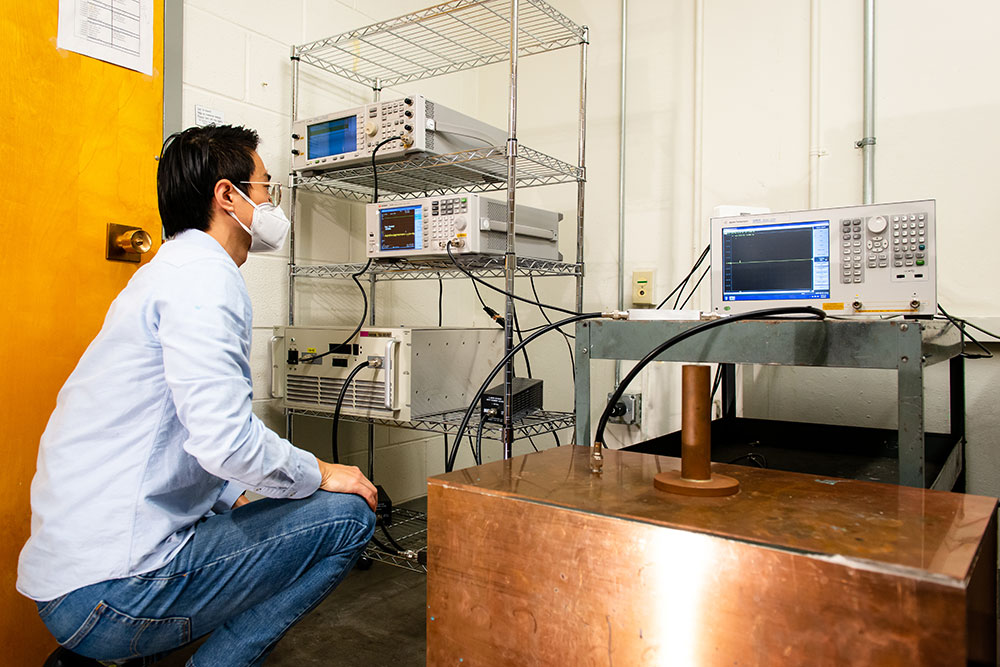
ME doctoral student Shen Ren works with professor Dayong Gao on advancing technology for preserving human and biological samples. Photo by Olivia Hagan / University of Washington
The idea of freezing and many years later thawing out the human body has been a favorite of storytellers for decades, including for popular characters like Captain America and Austin Powers. But the science of cryopreservation may be even more interesting.
Dayong Gao
Dayong Gao is a Professor of Mechanical Engineering and an internationally recognized scientist in cryo-biomedical engineering. Recently, the Society for Cryobiology created the Dayong Gao Young Investigator Award to recognize the field’s best early career researchers.
ME’s Andy Freeberg interviewed Gao on his research and attempted to separate the science from the fiction.
How did scientists get started freezing biological samples?
Scientists proposed the idea of keeping cells dormant by freezing them a long time ago. This was based on the scientific principle that life is a biochemical process with a temperature-dependent rate. The rate slows as you cool down until eventually all of life’s processes stop. However, there’s a big contradiction between that concept and the experimental findings. At very low temperatures bioactivity does indeed stop, but early scientists found cells and tissues were killed by the freezing and thawing process itself.
The first successful preservation of mammalian cells didn’t occur until 1949, when Christopher Polge discovered that glycerol can prevent freezing injury. Polge was studying rooster sperm and using glycerol to add viscosity to some samples to study sperm motion. Separately he was using liquid nitrogen to freeze other samples and look at their structure. But he accidentally confused a sample with glycerol in it and put it in the liquid nitrogen. After the sample warmed back up, he was surprised to see sperm that were still moving – at that point no one had reported that sperm could be frozen without killing them.
When he figured out what he had done, he repeated the experiment and showed that glycerol is what we now call a cryoprotective agent, or CPA. That really kicked this all off.
How did you get interested in cryopreservation?
That brings us to another major milestone in cryopreservation by Peter Mazur, who in the late 60s and early 70s reported on the actual mechanism for freezing injury due to ice crystallization. Mazur showed that each kind of cell has its own optimal freezing and thawing rate. Freeze it too fast and you get intracellular ice formation, which kills the cell. Freeze it too slow and you get severe dehydration damage.
I was a postdoctoral fellow under Mazur and John Critser, but my undergraduate training was in physics and mechanical engineering. My own interest arose from the challenges of biology. Whenever I asked a question in physics class the teachers could always give me the answer. But when I went to an introductory biology class, I couldn’t get a clear answer to even “simple” questions. So that’s why I got into biomedical engineering; it’s applying physics, mechanics and mathematics into biology and health.
What have been the most important recent advances in cryopreservation and what effect have they had?
We now know that the optimal freezing and thawing rates are specific to each cell type. However, when you start to consider whole organs, embryos or tissues, this becomes a problem. These samples have different cell types. How do you make sure that the surface cooling is the same as the interior? And it turns out that even if all the cells survive, the ways the cells communicate may not.
So the new hope for cryopreservation is something called vitrification, or “glassification.” It’s not actually freezing at all, because there’s no ice crystal formation. Instead the water molecules simply become solid in their disordered, amorphous state.
The key to vitrification is that we eliminate ice crystal induced damage. As a result, vitrification is the most promising cryopreservation method for larger tissues, organs, and reproductive samples like embryos and eggs.
However, despite some successes, vitrification still has two big challenges. To make it work, you need either a cooling rate of over a million degrees per minute, which is basically impossible for a large sample, or you need a very high concentration of CPAs to make the sample viscous and prevent ice crystal formation. But that much CPA becomes toxic to the cells. These are the things we’re working on now.
What kinds of developments are happening in your lab?
We’ve been investigating an array of areas in cryopreservation, including some of the fundamental problems I’ve mentioned as well as a number of new potential applications. One of our most exciting recent advances involves re-warming frozen or vitrified cells and organs.
The conventional rewarming method, using a hot water bath, doesn’t work for larger samples. Its heating is slow and uneven and irreparably damages the samples. We have been developing a new kind of single-mode electromagnetic resonance technology.
When you use your microwave at home, you’re using electromagnetic warming. But a microwave oven generates hundreds of modes, or frequencies. Our single mode system can add energy rapidly and is much easier to control.

A new single-mode electromagnetic resonance system developed by Gao's team uses electromagnetic energy to rewarm cryopreserved samples. Photo by Olivia Hagan / University of Washington
Part of our challenge is that certain molecules absorb the energy differently than others. To help with that problem, we load the CPA with magnetic nanoparticles that absorb the energy effectively and distribute the heat quickly and uniformly. We’ve had great results in cell survival with our tests and believe devices like we’re designing could be used in hospitals in the near future.
What's next? Will the science fiction idea of freezing someone and thawing them out years later ever come true?
Freezing human bodies in the hope of future revival is something people always ask me about. There are companies that do this, they mimic what we’re doing in cryobiology and attempt to preserve people who have recently passed away. Hundreds of bodies are currently cryopreserved in liquid nitrogen tanks even though there’s no rewarming method now that would ensure their survival after thawing.
If you had asked me the question 20 years ago, I would’ve told you it’s pure science fiction. But now I have to tell you, in the future I think anything is possible. Cryopreservation and biobanking have already become indispensable in modern medicine and across industries like healthcare, agriculture, environmental conservation and biotech. In our labs we’re developing new technology to meet urgent needs in cellular and gene therapy, regenerative medicine, tissue engineering, stem cell and organ transplantation, new vaccine and drug development, disease screening, and fertility treatments. Plus, this is the biological information age – the preservation of genes, seed banks, the gametes of endangered species, and so on. When you think about all of these things taken together it’s very exciting.
Find out more
Gao’s team’s paper “Investigation of Electromagnetic Resonance Rewarming Enhanced by Magnetic Nanoparticles for Cryopreservation” was published last year in the journal Langmuir.
To learn more about the history of cryopreservation, see a 2009 article penned by Gao and two colleagues titled “Cryopreservation: An emerging paradigm change.”
Originally published September 1, 2020